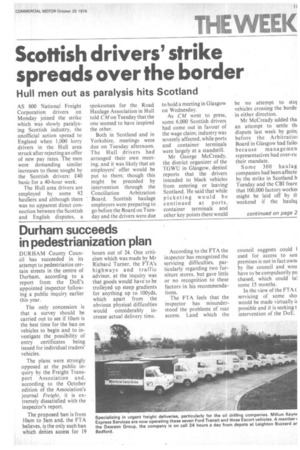Durham succeeds in pedestrianization plan
Page 19

If you've noticed an error in this article please click here to report it so we can fix it.
DURHAM County Council has succeeded in its attempt to pedestrianize certain streets in the centre of Durham, according to a report from the DoE's appointed inspector following a public inquiry earlier this year.
The only concession is that a survey should be carried out to see if 10am is the best time for the ban on vehicles to begin and to investigate the possibility of entry certificates being issued for individual traders' vehicles.
The plans were strongly opposed at the public inquiry by the Freight Transport Association and, according to the October edition of the Association's journal Freight, it is extremely dissatisfied with the inspector's report.
The proposed ban is from 10am to 5am and. the FTA believes, is the only such ban which denies access for 19 hours out of 24. One criticism which was made by Mr Richard Turner. the FTA's highways and traffic advisor, at the inquiry was that goods would have to be trolleyed up steep gradients for anything up to 100yds, which apart from the obvious physical difficulties would considerably increase actual delivery time. According to the FTA the in3pector has recognized the servicing difficulties, particularly regarding two furniture stores, but gave little or no recognition to these factors in his recommendations.
The FTA feels that the inspector has misunderstood the problems of rear access. Land which the council suggests could 1 used for access to son premises is not in fact own( by ihe council and wou have to be compulsorily pu chased, which could tal some 15 months.
In the view of the FTA t servicing of some sho would be made virtually it possible and it is seeking t intervention of the DoE.












































































































































